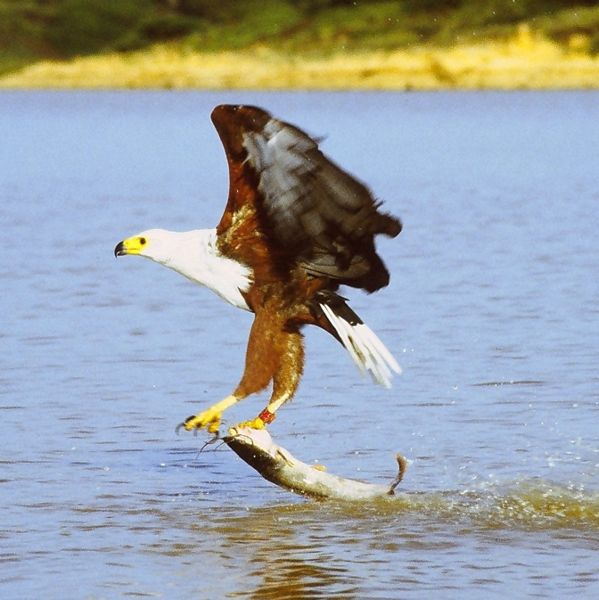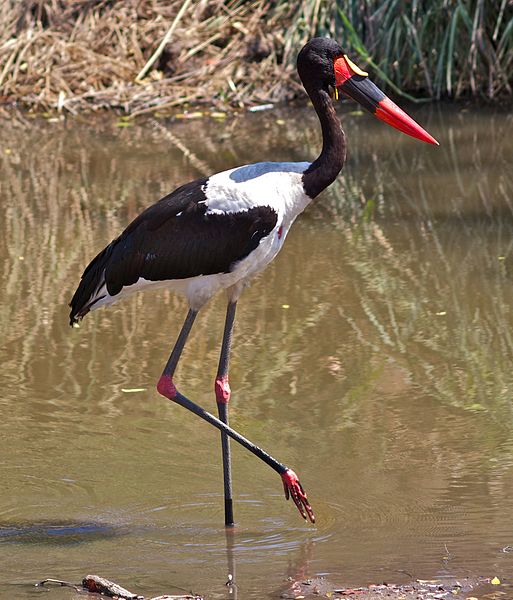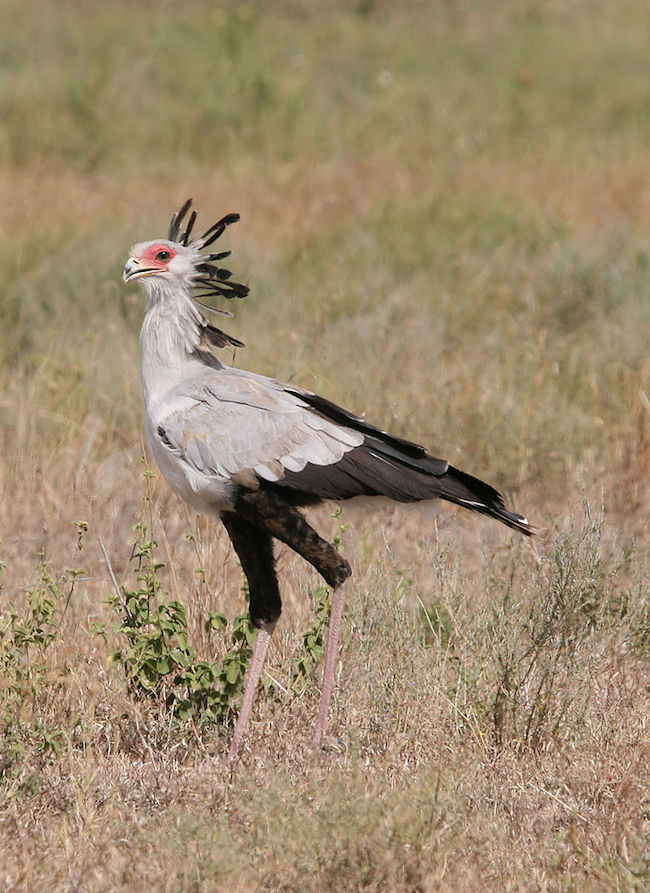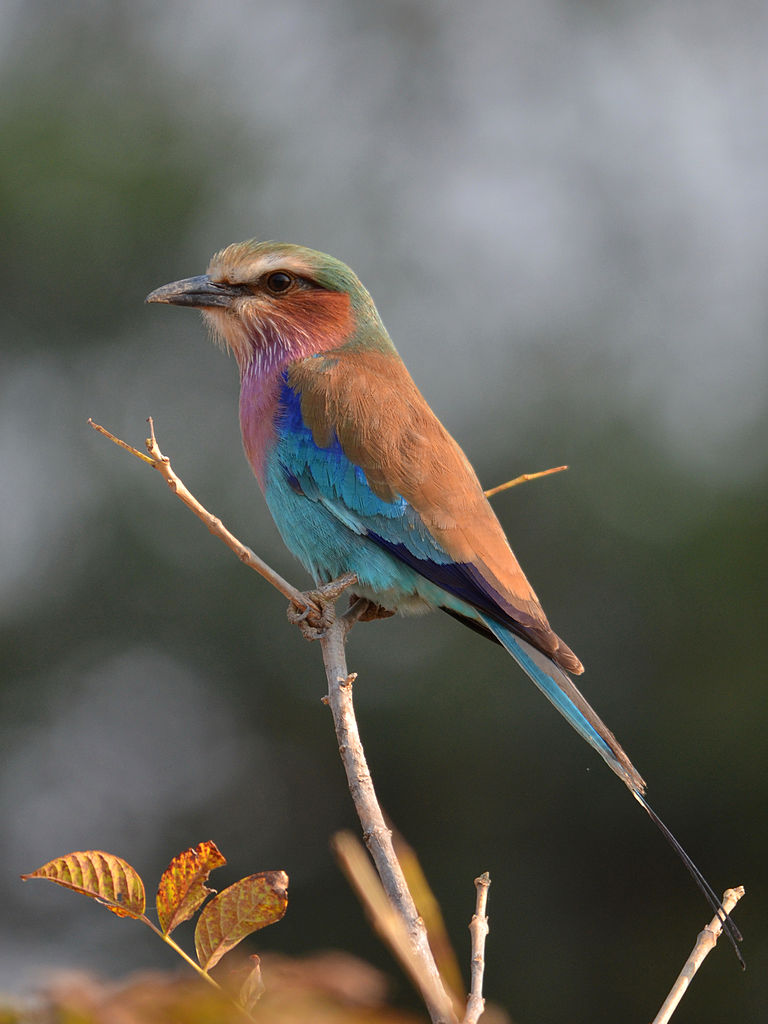If any place in the world can turn someone into a birdwatcher, it’s Africa. The staggering abundance and diversity of birdlife often surprises first time safari goers. Over 1,100 species have been identified in Kenya alone, about 200 more than have been spotted in all of North America. So it’s not surprising that many people, after spending a few days staring in amazement at the big animals that they came to see, find themselves paying closer and closer attention to what’s happening in the trees and overhead. In parts of Botswana , it’s not uncommon to see three or four species of eagles on a single afternoon outing during certain times of the year (I live near a river in Colorado and am lucky if I see three bald eagles a year). Throw in all kinds of crazy looking herons, cranes, storks, hawks, kites, rails, crakes, darters, plovers, parrots, macaws, vultures, owls, turacos, hornbills, cuckoos, hoopoes, hornbills, flycatchers, trogons, and kingfishers and you start to get the picture: there is almost always an interesting bird in sight, even when the lions are asleep and the leopards are hiding.
Here a few fairly common African bird species that will likely be among the first to catch your eye while on safari — and possibly help turn you into a full-fledged birdwatcher:
African Fish Eagle This majestic species of sea eagle is commonly seen perched in high treetops near lakes, rivers and lagoons throughout much of sub-Saharan Africa. It is similar in appearance to the bald eagle, and like its North America cousin, it primarily eats fish. The wingspans of females, which are larger than males, can reach up to eight feet.
Saddle-billed Stork Watching a stately and colorful saddle billed stork patiently wade through shallow waters in search of frogs, toads and crabs can be a mesmerizing experience. Reaching nearly five feet in height and with wingspans up to almost nine feet, it is the largest (though not the heaviest) stork in the world.
Secretary Bird This large, striking bird has been described as having the body of an eagle and the legs of a crane. It is the tallest and longest species of raptor and one of the few birds of prey that spends most of its time on the ground. It hunts, often in pairs, for everything from insects to tortoises to large snakes. There are even reports of secretary birds killing young gazelles.
Lilac-Breasted Roller With its pastel plumage of impossible-to-describe shades of green, violet and blue, the lilac-breasted roller is widely considered one of the world’s most beautiful birds. It is commonly spotted throughout much of sub-Saharan Africa and is the national bird of both Kenya and Botswana.
Carmine Bee-Eater With its almost jewel-like carmine (deep red) coloration, the migratory carmine bee-eater is another show stopper. As its name suggests, it feeds by catching bees and other insects in midflight. There are two different species, northern and southern, which look similar and are found in different areas. They can be seen in great numbers as they nest in vertical or nearly vertical earthen banks along rivers, streams and other bodies of water.
Request Your 2025/2026 Catalog
Discover the World's Best
Nature Travel Experiences
Together, Natural Habitat Adventures and World Wildlife Fund have teamed up to arrange nearly 100 nature travel experiences around the planet, while helping to protect the magnificent places we visit and their wild inhabitants.
Discover the World's Best
Nature Travel Experiences
Our weekly eNewsletter highlights new adventures, exclusive offers, webinars, nature news, travel ideas, photography tips and more. Sign up today!
Hidden form View
Home Trips Trips Catalog Catalog
Book
Contact Contact More More Have a question or comment? Hours Mountain Time
×
Home
Trips
Trips
Catalog
Catalog
Book
Contact
Contact
More
More
[ebook-modal-wrapper]
[ebook-modal-wrapper]
[full-width-start]
[full-width-start]
[full-width-end]
[full-width-end]
[aside-height-start]
[aside-height-start]
[aside-height-end form-start]
[aside-height-end form-start]
[aside-content-start aside-text-start]
[aside-content-start aside-text-start]
[aside-text-end]
[aside-text-end]
[aside-image-start]
[aside-image-start]
[aside-image-end aside-content-end]
[aside-image-end aside-content-end]
[content-start subheader-start]
[content-start subheader-start]
[subheader-end main-header-start]
[subheader-end main-header-start]
[main-header-end image-height-start]
[main-header-end image-height-start]
[image-height-end content-end]
[image-height-end content-end]
[ebook-header-optin]
[ebook-header-optin]
[ebook-subheader-optin]
[ebook-subheader-optin]
[ebook-aside-image]
[ebook-aside-image]
[ebook-aside-text]
[ebook-aside-text]
[ebook-logos]
[ebook-logos]
[form-header-start]
[form-header-start]
[form-header-end form-start]
[form-header-end form-start]
[ebook-header-form]
[ebook-header-form]
[privacy-policy]
[privacy-policy]
[ebook-form-sms-text-wrapper]
[ebook-form-sms-text-wrapper]
[ebook-sms-privacy-wrapper]
[ebook-sms-privacy-wrapper]
[ebook-sms-fine-print]
[ebook-sms-fine-print]
[ebook-submit-button]
[ebook-submit-button]
[ebook-header-success]
[ebook-header-success]
[ebook-success-text]
[ebook-success-text]
[thank-you-start]
[thank-you-start]
[thank-you-end link-text-start]
[thank-you-end link-text-start]
[link-text-end]
[link-text-end]
[aside-start]
[aside-start]
[aside-end form-start]
[aside-end form-start]
[content-start]
[content-start]
[content-end]
[content-end]
[aside-content-start aside-image-start]
[aside-content-start aside-image-start]
[aside-image-end]
[aside-image-end]
[aside-text-start logos-start]
[aside-text-start logos-start]
[aside-text-end logos-end aside-content-end]
[aside-text-end logos-end aside-content-end]
[subheader-start]
[subheader-start]
[main-header-end aside-image-start aside-text-start]
[main-header-end aside-image-start aside-text-start]
[aside-text-end logos-start]
[aside-text-end logos-start]
[aside-image-end logos-end]
[aside-image-end logos-end]
[ebook-modal-wrapper]
[ebook-modal-wrapper]
[full-width-start]
[full-width-start]
[full-width-end]
[full-width-end]
[aside-height-start]
[aside-height-start]
[aside-height-end form-start]
[aside-height-end form-start]
[aside-content-start aside-text-start]
[aside-content-start aside-text-start]
[aside-text-end]
[aside-text-end]
[aside-image-start]
[aside-image-start]
[aside-image-end aside-content-end]
[aside-image-end aside-content-end]
[content-start subheader-start]
[content-start subheader-start]
[subheader-end main-header-start]
[subheader-end main-header-start]
[main-header-end image-height-start]
[main-header-end image-height-start]
[image-height-end content-end]
[image-height-end content-end]
[ebook-header-optin]
[ebook-header-optin]
[ebook-subheader-optin]
[ebook-subheader-optin]
[ebook-aside-image]
[ebook-aside-image]
[ebook-aside-text]
[ebook-aside-text]
[ebook-logos]
[ebook-logos]
[form-header-start]
[form-header-start]
[form-header-end form-start]
[form-header-end form-start]
[ebook-header-form]
[ebook-header-form]
[privacy-policy]
[privacy-policy]
[ebook-form-sms-text-wrapper]
[ebook-form-sms-text-wrapper]
[ebook-sms-privacy-wrapper]
[ebook-sms-privacy-wrapper]
[ebook-sms-fine-print]
[ebook-sms-fine-print]
[ebook-submit-button]
[ebook-submit-button]
[ebook-header-success]
[ebook-header-success]
[ebook-success-text]
[ebook-success-text]
[thank-you-start]
[thank-you-start]
[thank-you-end link-text-start]
[thank-you-end link-text-start]
[link-text-end]
[link-text-end]
[aside-start]
[aside-start]
[aside-end form-start]
[aside-end form-start]
[content-start]
[content-start]
[content-end]
[content-end]
[aside-content-start aside-image-start]
[aside-content-start aside-image-start]
[aside-image-end]
[aside-image-end]
[aside-text-start logos-start]
[aside-text-start logos-start]
[aside-text-end logos-end aside-content-end]
[aside-text-end logos-end aside-content-end]
[subheader-start]
[subheader-start]
[main-header-end aside-image-start aside-text-start]
[main-header-end aside-image-start aside-text-start]
[aside-text-end logos-start]
[aside-text-end logos-start]
[aside-image-end logos-end]
[aside-image-end logos-end]
[ebook-modal-wrapper]
[ebook-modal-wrapper]
[ebook-background-image]
[ebook-background-image]
[ebook-header-optin]
[ebook-header-optin]
[ebook-subheader-optin]
[ebook-subheader-optin]
[privacy-policy]
[privacy-policy]
[ebook-form-sms-text-wrapper]
[ebook-form-sms-text-wrapper]
[ebook-sms-privacy-wrapper]
[ebook-sms-privacy-wrapper]
[ebook-sms-fine-print]
[ebook-sms-fine-print]
[ebook-submit-button]
[ebook-submit-button]
[ebook-header-success]
[ebook-header-success]
[ebook-success-text]
[ebook-success-text]
[full-width-start]
[full-width-start]
[full-width-end]
[full-width-end]
[image-height-start]
[image-height-start]
[image-height-end content-start]
[image-height-end content-start]
[content-end]
[content-end]
[content-start subheader-start]
[content-start subheader-start]
[subheader-end main-header-start]
[subheader-end main-header-start]
[main-header-end form-start]
[main-header-end form-start]
[form-end content-end]
[form-end content-end]
[full-width-start logos-start]
[full-width-start logos-start]
[image-height-start logos-start]
[image-height-start logos-start]
[logos-start]
[logos-start]
[logos-end content-start]
[logos-end content-start]
[full-height-start]
[full-height-start]
[logos-start content-start]
[logos-start content-start]
[logos-end content-end full-height-end]
[logos-end content-end full-height-end]
[main-header-start]
[main-header-start]
[main-header-end subheader-start]
[main-header-end subheader-start]
[subheader-end form-start]
[subheader-end form-start]
[thank-you-start]
[thank-you-start]
[thank-you-end link-text-start]
[thank-you-end link-text-start]
[link-text-end]
[link-text-end]
[ebook-modal-wrapper]
[ebook-modal-wrapper]
[ebook-background-image]
[ebook-background-image]
[ebook-header-optin]
[ebook-header-optin]
[ebook-subheader-optin]
[ebook-subheader-optin]
[privacy-policy]
[privacy-policy]
[ebook-form-sms-text-wrapper]
[ebook-form-sms-text-wrapper]
[ebook-sms-privacy-wrapper]
[ebook-sms-privacy-wrapper]
[ebook-sms-fine-print]
[ebook-sms-fine-print]
[ebook-submit-button]
[ebook-submit-button]
[ebook-header-success]
[ebook-header-success]
[ebook-success-text]
[ebook-success-text]
[full-width-start]
[full-width-start]
[full-width-end]
[full-width-end]
[image-height-start]
[image-height-start]
[image-height-end content-start]
[image-height-end content-start]
[content-end]
[content-end]
[content-start subheader-start]
[content-start subheader-start]
[subheader-end main-header-start]
[subheader-end main-header-start]
[main-header-end form-start]
[main-header-end form-start]
[form-end content-end]
[form-end content-end]
[full-width-start logos-start]
[full-width-start logos-start]
[image-height-start logos-start]
[image-height-start logos-start]
[logos-start]
[logos-start]
[logos-end content-start]
[logos-end content-start]
[full-height-start]
[full-height-start]
[logos-start content-start]
[logos-start content-start]
[logos-end content-end full-height-end]
[logos-end content-end full-height-end]
[main-header-start]
[main-header-start]
[main-header-end subheader-start]
[main-header-end subheader-start]
[subheader-end form-start]
[subheader-end form-start]
[thank-you-start]
[thank-you-start]
[thank-you-end link-text-start]
[thank-you-end link-text-start]
[link-text-end]
[link-text-end]
[ebook-modal-wrapper]
[ebook-modal-wrapper]
[ebook-background-image]
[ebook-background-image]
[ebook-header-optin]
[ebook-header-optin]
[ebook-subheader-optin]
[ebook-subheader-optin]
[privacy-policy]
[privacy-policy]
[ebook-form-sms-text-wrapper]
[ebook-form-sms-text-wrapper]
[ebook-sms-privacy-wrapper]
[ebook-sms-privacy-wrapper]
[ebook-sms-fine-print]
[ebook-sms-fine-print]
[ebook-submit-button]
[ebook-submit-button]
[ebook-header-success]
[ebook-header-success]
[ebook-success-text]
[ebook-success-text]
[full-width-start]
[full-width-start]
[full-width-end]
[full-width-end]
[image-height-start]
[image-height-start]
[image-height-end content-start]
[image-height-end content-start]
[content-end]
[content-end]
[content-start subheader-start]
[content-start subheader-start]
[subheader-end main-header-start]
[subheader-end main-header-start]
[main-header-end form-start]
[main-header-end form-start]
[form-end content-end]
[form-end content-end]
[full-width-start logos-start]
[full-width-start logos-start]
[image-height-start logos-start]
[image-height-start logos-start]
[logos-start]
[logos-start]
[logos-end content-start]
[logos-end content-start]
[full-height-start]
[full-height-start]
[logos-start content-start]
[logos-start content-start]
[logos-end content-end full-height-end]
[logos-end content-end full-height-end]
[main-header-start]
[main-header-start]
[main-header-end subheader-start]
[main-header-end subheader-start]
[subheader-end form-start]
[subheader-end form-start]
[thank-you-start]
[thank-you-start]
[thank-you-end link-text-start]
[thank-you-end link-text-start]
[link-text-end]
[link-text-end]
[ebook-modal-wrapper]
[ebook-modal-wrapper]
[ebook-background-image]
[ebook-background-image]
[ebook-header-optin]
[ebook-header-optin]
[ebook-subheader-optin]
[ebook-subheader-optin]
[privacy-policy]
[privacy-policy]
[ebook-form-sms-text-wrapper]
[ebook-form-sms-text-wrapper]
[ebook-sms-privacy-wrapper]
[ebook-sms-privacy-wrapper]
[ebook-sms-fine-print]
[ebook-sms-fine-print]
[ebook-submit-button]
[ebook-submit-button]
[content-start main-header-start]
[content-start main-header-start]
[main-header-end subheader-start]
[main-header-end subheader-start]
[subheader-end content-end]
[subheader-end content-end]
[ebook-header-success]
[ebook-header-success]
[ebook-success-text]
[ebook-success-text]
[full-width-start]
[full-width-start]
[full-width-end]
[full-width-end]
[image-height-start]
[image-height-start]
[image-height-end content-start]
[image-height-end content-start]
[content-end]
[content-end]
[content-start subheader-start]
[content-start subheader-start]
[subheader-end main-header-start]
[subheader-end main-header-start]
[main-header-end form-start]
[main-header-end form-start]
[form-end content-end]
[form-end content-end]
[full-width-start logos-start]
[full-width-start logos-start]
[image-height-start logos-start]
[image-height-start logos-start]
[logos-start]
[logos-start]
[logos-end content-start]
[logos-end content-start]
[full-height-start]
[full-height-start]
[logos-start content-start]
[logos-start content-start]
[logos-end content-end full-height-end]
[logos-end content-end full-height-end]
[main-header-start]
[main-header-start]
[subheader-end form-start]
[subheader-end form-start]
[thank-you-start]
[thank-you-start]
[thank-you-end link-text-start]
[thank-you-end link-text-start]
[link-text-end]
[link-text-end]
[ebook-modal-wrapper]
[ebook-modal-wrapper]
[ebook-background-image]
[ebook-background-image]
[ebook-header-optin]
[ebook-header-optin]
[ebook-subheader-optin]
[ebook-subheader-optin]
[privacy-policy]
[privacy-policy]
[ebook-form-sms-text-wrapper]
[ebook-form-sms-text-wrapper]
[ebook-sms-privacy-wrapper]
[ebook-sms-privacy-wrapper]
[ebook-sms-fine-print]
[ebook-sms-fine-print]
[ebook-submit-button]
[ebook-submit-button]
[ebook-header-success]
[ebook-header-success]
[ebook-success-text]
[ebook-success-text]
[full-width-start]
[full-width-start]
[full-width-end]
[full-width-end]
[image-height-start]
[image-height-start]
[image-height-end content-start]
[image-height-end content-start]
[content-end]
[content-end]
[content-start subheader-start]
[content-start subheader-start]
[subheader-end main-header-start]
[subheader-end main-header-start]
[main-header-end form-start]
[main-header-end form-start]
[form-end content-end]
[form-end content-end]
[full-width-start logos-start]
[full-width-start logos-start]
[image-height-start logos-start]
[image-height-start logos-start]
[logos-start]
[logos-start]
[logos-end content-start]
[logos-end content-start]
[full-height-start]
[full-height-start]
[logos-start content-start]
[logos-start content-start]
[logos-end content-end full-height-end]
[logos-end content-end full-height-end]
[main-header-start]
[main-header-start]
[main-header-end subheader-start]
[main-header-end subheader-start]
[subheader-end form-start]
[subheader-end form-start]
[thank-you-start]
[thank-you-start]
[thank-you-end link-text-start]
[thank-you-end link-text-start]
[link-text-end]
[link-text-end]
































